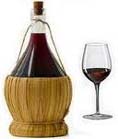Plates
from Italian Traditional Food
History of plates
What do you know
about plates?
We all use plates, and we all take them for
granted. Here is a potted history of plates and china. It was as long ago as the 6th century that the Chinese discovered how to make porcelain - by
fusing together two kinds of feldspathic rock- but it was not until a thousand years later that articles made of
this strange and delicate substance began to find their way across the world.
European countries such as France, Germany and Italy took the first pieces and
then eventually some of them came to England. These were coverted and admired,
like early Meissen and Chelsea wares today, but not imitated. In fact, no one thought seriously of producing
porcelain for home consumption until the early 18th century. The ordinary folk were content with wooden vessels and
tough earthenware, and the wealthy had their silver, gold and pewter plate.
At last it was realised that porcelain was different, decorative and marketable,
and factories were set up, the earliest being at Chelsea and Bow (1744), then Bristol, Worcester, Derby and later
Nantgarw (1811) and Swansea (1814).
The last two centres naturally fall together because, besides being both Welsh and
for a time under the same management, their early wares of soft-paste porcelain are considered outstanding, even
among collectors' pieces.
Later, reflecting a change in management, Swansea paste became harder and took on
a greenish tinge. Because of the small range of shapes produced, a collector's interest centres on the designs.
There were mainly floral, one might almost say botanical.
It's unlikely that you'll come across a Swansea plate on a casual rummage, but its
mark (found underneath) is the word itself in capitals, with a single trident, or two tridents crossed. Some plates
have a red stencil mark instead, and it was this that was copied so well by the Coalport factory after Swansea
ceased production about 1824.
Thomas Minton started his factory at Stoke-on-Trent in 1796 - his name is still a
household word. He produced a great deal of tableware in soft-paste porcelain, and went on, in the mid-19th
century, to make elaborately fashionable vases after the French styles of Sevres - many indistinguishable from the
genuine article apart from the initial "M" after the Sevres mark.
Page 2 of this Italian Traditional Food article on
plates can be found on the next page.
Page 1 Next
>>

Copyright © 2009 -
. All Rights Reserved Worldwide. Italian Traditional Food
You may not reprint articles from this website
without the written permission of the site owner.
Disclaimer: Articles on this
Website are provided for information purposes only. Italiantraditionalfood.com does not accept any responsibility
or liability for the use or misuse of the article content on this site or reliance by any person on the site's
contents.
| 


 Digg
Digg Stumbleupon
Stumbleupon Google Bookmarks
Google Bookmarks Delicious
Delicious Twitter
Twitter Facebook
Facebook Yahoo My Web
Yahoo My Web Reddit
Reddit